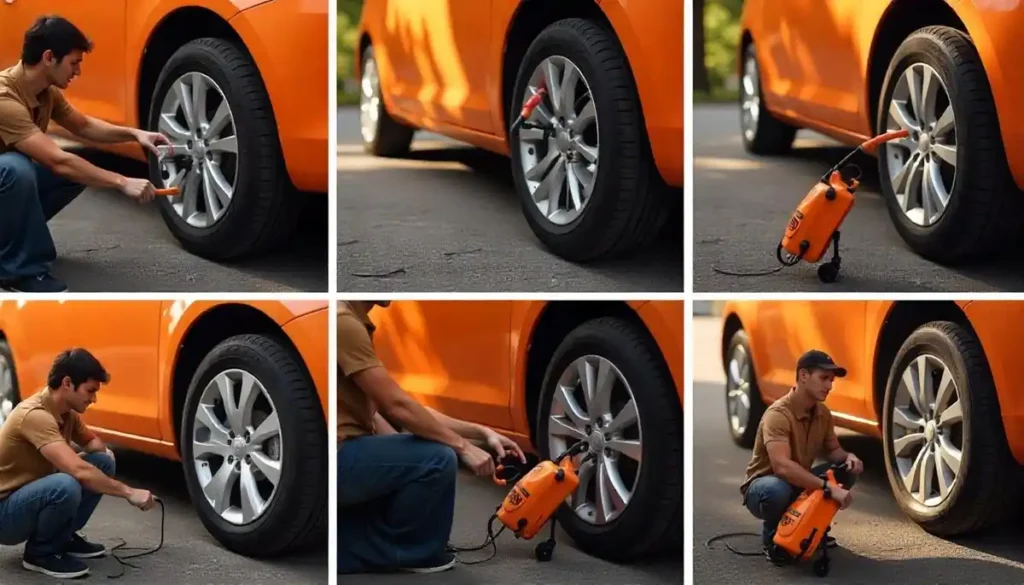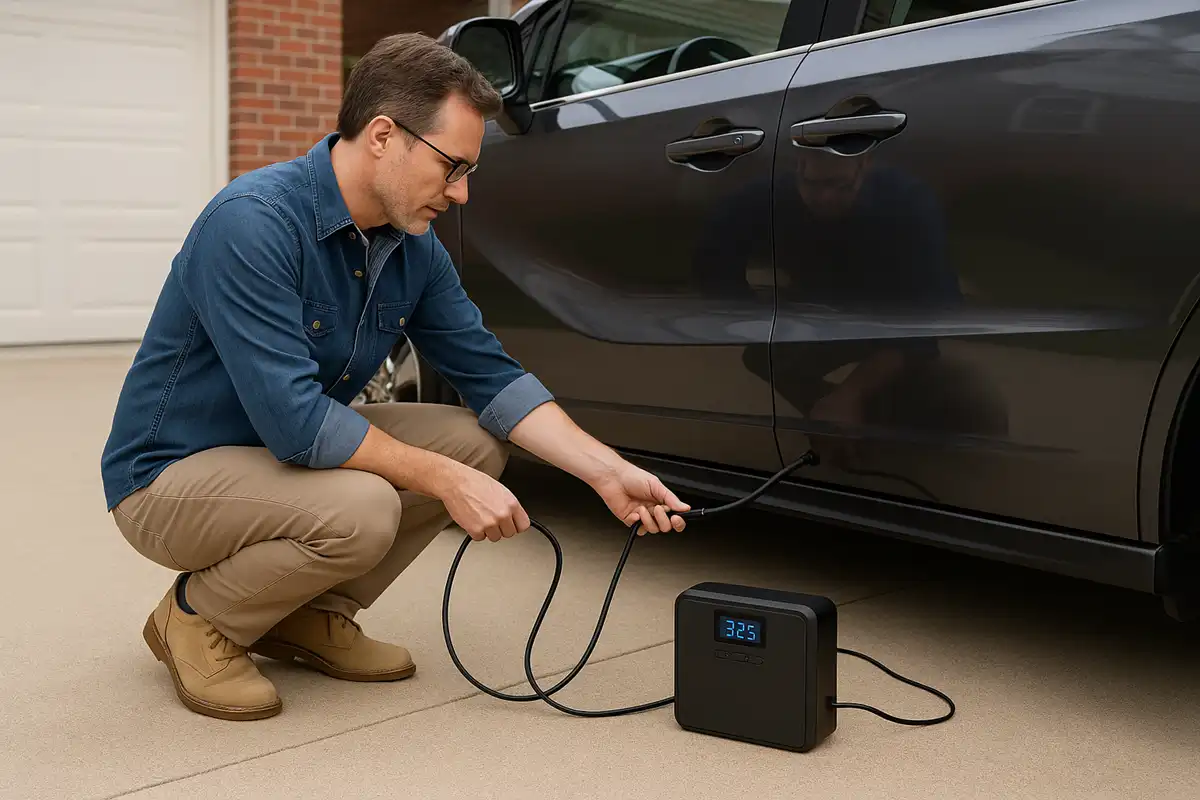Low tire pressure isn’t just inconvenient—it’s a hazard. Underinflated tires can affect handling, reduce fuel efficiency, cause uneven tire wear, and increase the risk of blowouts. Fortunately, technology has made tire care easier than ever. Portable air compressors have become smarter, lighter, and more user-friendly, empowering drivers to take charge of their vehicle’s tire maintenance anytime, anywhere.
Whether you’re at home, on a road trip, or dealing with a slow leak, this guide will walk you through the latest techniques for safely and efficiently inflating your tires with a portable air compressor. By the end, you’ll have the confidence and know-how to maintain proper tire pressure without needing to visit a gas station.
What You Need Before You Start
Before diving into the process, it’s important to gather the right tools and materials. Here’s what you’ll need:
✅ Portable Air Compressor
Choose a model that suits your vehicle type and driving habits. Cordless models with lithium-ion batteries are ideal for convenience, while 12V plug-in compressors are perfect for long drives.
✅ Tire Pressure Gauge
Even if your compressor includes one, having a separate digital gauge can provide a second level of accuracy.
✅ Know Your Vehicle’s PSI
The correct tire pressure is usually found on a sticker on the driver-side door frame or inside your owner’s manual. Typical ranges for passenger vehicles are between 30–36 PSI.
✅ Power Source
For cordless models, ensure the battery is fully charged. For wired compressors, check that the 12V socket is functional.
Safety First: Precautions Before Inflating
Inflating tires might seem straightforward, but taking safety precautions ensures a smooth and injury-free process.
- Park on a flat surface: Prevents the vehicle from rolling or shifting.
- Use the handbrake: Essential for stability.
- Let tires cool: Tire pressure increases with heat; checking PSI on a hot tire can lead to inaccurate inflation.
- Wear gloves and safety glasses: Especially if you’re using a high-pressure or heavy-duty inflator.
Step-by-Step: How to Inflate a Tire
4.1 Locate the Valve Stem
Each tire has a small valve stem where you attach the compressor. Remove the cap and store it safely—losing it could expose the valve to dust and moisture.
4.2 Check the Current Tire Pressure
Using a tire pressure gauge, check the PSI. If your vehicle has TPMS, compare your reading to the digital display on the dashboard. Note which tires are underinflated.
4.3 Connect the Air Compressor
Attach the compressor’s nozzle to the valve stem. It should feel secure, with no air hissing out. Newer compressors come with screw-on or lever-lock connectors for a tight seal.
4.4 Power On and Inflate
Turn on the compressor and begin inflating. Many modern models have digital controls where you can set your target PSI, and the unit will shut off automatically once it’s reached. Watch the gauge closely if your model is manual.
4.5 Disconnect and Recheck
Once the desired PSI is reached, disconnect the hose quickly to minimize air loss. Check pressure again to ensure it’s within the correct range. Replace the valve cap.

Latest Tech: Smart Air Compressors in 2025
The year 2025 has brought a new wave of innovation to portable air compressors. Here’s what’s trending:
- Bluetooth Connectivity: Sync your compressor with a smartphone app to monitor pressure, get alerts, and adjust settings remotely.
- Voice Activation: Use smart assistants like Alexa or Google Assistant to start or stop inflation.
- Cordless Convenience: USB-C charging and long-lasting lithium-ion batteries allow freedom from wires.
- Integrated TPMS Readers: Some models can read your tire pressure directly through your valve stem.
These features save time, reduce guesswork, and provide peace of mind during emergency situations.
Common Mistakes to Avoid
Even with great tools, user error can lead to incorrect inflation or damage. Avoid these common mistakes:
- Guessing the PSI: Always refer to your vehicle’s official PSI recommendations.
- Overinflating the tires: This can cause excessive wear in the center of the tread and reduced traction.
- Ignoring the rear tires: Some vehicles have different PSI needs for front and rear tires.
- Using the wrong compressor setting or adapter: Sports nozzles won’t work properly on car tires.
- Inflating tires when they’re hot: Wait at least 30 minutes after driving for a more accurate reading.
Tips for Emergency Situations
A portable air compressor is your best friend during roadside emergencies. Here’s how to use it effectively in high-pressure moments:
- Pull over safely: Choose a flat area with good visibility.
- Turn on hazard lights: Alert passing drivers.
- Inspect the tire: Look for punctures or sidewall damage.
- Inflate cautiously: If you notice rapid deflation, it may not be safe to continue driving.
- Use a sealant (if available): Many compressors come with tire sealant kits for temporary fixes.
Maintenance & Storage Tips
Taking care of your portable air compressor ensures it’s always ready when you need it.
- Clean the nozzle and hose: Wipe after use to prevent dirt buildup.
- Avoid leaving in extreme temperatures: Prolonged heat or cold can damage the battery.
- Keep the unit charged (for cordless): Recharge every few months even if unused.
- Store in a case or pouch: Many compressors come with carrying bags—use them to avoid cord tangles.
FAQs: Frequently Asked Questions
1. Can I use a portable air compressor for bike tires or sports balls?
- Yes, most compressors come with multiple nozzles that fit bikes, footballs, basketballs, and inflatables.
2. How long does it take to inflate a flat car tire?
- Typically 2 to 5 minutes depending on the compressor’s PSI output and the tire size.
3. Is it okay to leave the compressor unattended while inflating?
- Not recommended unless your compressor has auto shutoff. Always monitor inflation for safety.
4. How do I know if my tire is overinflated?
- Use a pressure gauge to double-check. Overinflated tires will feel harder and may show more wear in the center of the tread.
5. What PSI should I inflate to in summer or winter?
- Always follow your vehicle’s recommended PSI, but check more frequently during seasonal changes. Cold air can reduce tire pressure.
6. Do I need to turn off the car while using a 12V compressor?
- Leave the car in ACC (accessory) mode to power the 12V socket, but keep the engine off unless advised by the manual.
7. Can I use a tire inflator on a completely flat tire?
- Yes, but only for short-term emergency use. A completely flat tire may also be damaged and should be inspected by a professional.
8. Will a portable compressor work for a large SUV or truck?
- Yes, but make sure to choose a compressor with a higher PSI output (usually over 150 PSI) suitable for large or off-road tires.
Conclusion
Inflating your tires with a portable air compressor is one of the most empowering and useful car care skills you can learn. It takes only minutes and offers big returns in safety, performance, and fuel savings. With modern smart compressors, it’s easier and more accurate than ever.
Don’t wait for your dashboard warning light—make tire checks and inflations a monthly habit. And always keep a portable air compressor in your trunk; it’s one of the most valuable tools you can own.

